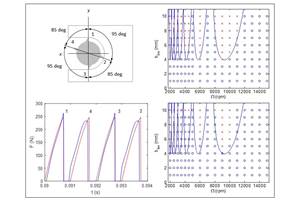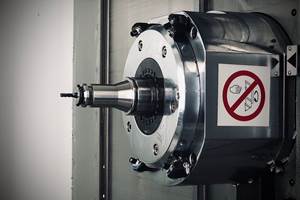Multiple Layer Coatings Keep Microcracks From Destroying Inserts
One reason why cutting tool inserts fail is that microcracks start in the top coating and work down to the substrate, eventually exposing the unprotected substrate to the damaging forces at work during a machining process. Slowing the formation of these microcracks and preventing them from reaching the substrate should therefore increase insert life.
Share




One reason why cutting tool inserts fail is that microcracks start in the top coating and work down to the substrate, eventually exposing the unprotected substrate to the damaging forces at work during a machining process. Slowing the formation of these microcracks and preventing them from reaching the substrate should therefore increase insert life. That's the theory behind a new approach to coating technology recently introduced by Valenite Inc. of Madison Heights, Michigan. According to the company, this new technology results in a 400 percent increase in tool life compared to today's best performing grades.
The process is called Multi-Layer Chemical Vapor Deposition (MLCVD). The company says this development is the result of more than two years of work in its Material R&D Group. Applying more than one layer of a coating to the carbide substrate of an indexable insert is not new. For many years now, insert manufacturers have been applying multiple coats of materials like titanium nitride, titanium carbonitride, and aluminum oxide to protect a substrate from the effects of heat and friction during the cut. These coatings have been relatively thick, and for some applications, a family of grades has been developed with extra-thick coatings, referred to as Thick CVD.
The MLCVD concept takes this technology in a new and different direction, the company says. Instead of two or three fairly thick coatings, MLCVD applies up to 200 extremely thin coatings to the substrate. Valenite reports developing grades with 62 alternating layers of titanium carbide (TiC) and titanium carbonitride (TiCN), each in thicknesses measured in nanometers—a nanometer is one billionth of a meter, or one millionth of a millimeter. To put that in perspective, the company suggests this comparison: the thickness of one layer on an MLCVD insert is to a meter what a dime on the sidewalk is to the height of the World Trade Center in New York.
"To understand how this new technology works, consider what happens to an insert while it's in the cut," says Karl Katbi, Product Marketing Manager at Valenite. "It gets hot from the friction generated by the chip flowing over it. It's subjected to impact and thermal shock. And, sooner or later, all of this combines to produce a microcrack in the coating." That crack then works its way down through the coating until the structural integrity of the coating is compromised and then a piece spalls off. Eventually the substrate is exposed and the properties supplied by the coating are lost altogether, causing the insert to fail.
Mr. Katbi explains that inserts coated with MLCVD technology do not fail as readily for two reasons: smoothness of the surface and the physics associated with multiple layers. In an MLCVD insert, exactly the same forces are at work, but there are two things different about the coating. The coating produced is very smooth, so smooth in fact that every attempt to polish it has only made it rougher, the developers report. Consequently, there is very little friction to generate heat as the chip slides across the face of the insert. It tends to run cooler so it stays harder and more resistant to chemical attack. The result is longer tool life.
But, even an MLCVD coating cracks eventually, and when it does, the second difference comes into play. Once a crack begins in a conventional coating, it propagates rapidly through the monolithic coating layer until it reaches a boundary—the interface between two layers, for example. Then it stops.
In that conventional insert, a significant portion of the coating is lost when that happens because the coating layer is relatively thick. An MLCVD insert is different, the Valenite researchers point out. A surface microcrack in an MLCVD insert is stopped within nanometers by the boundary of the underlying multi-layer, they say. Its chances of propagating are thereby greatly reduced. And there are 62 boundaries for cracks to cross before they can reach the substrate.
"At every interface, the cracking process has to start all over again on a brand new coating surface. That takes time, roughly three to four times as long as the same processes in a conventionally coated insert grade," Mr. Katbi explains. These two factors produce a coating system that delivers three to four times the tool life of anything on the market today, he says.
Using this new approach to coating, Valenite has developed a new class of insert grades. The first two members of that class are SpectraMill SM245 for milling applications, and SpectraThread ST145 for threading and grooving. SpectraMill SM245 applies MLCVD technology to general milling applications on ferrous workpieces. SpectraThread ST145 is designed for threading and grooving. Both grades start with a substrate based on an existing grade but tailored for use under an MLCVD coating. Over that substrate are 62 alternating layers of titanium carbide and titanium carbonitride. Both grades are available in many styles and chipbreakers for applications on a range of steels and stainless steels. The company is reporting that, in field tests, the milling inserts consistently delivered four times the tool life of competitive milling grades and the threading/grooving inserts consistently delivered three to four times the tool life of competitive threading and grooving grades.
To produce the new grades with MLCVD technology in commercial quantities, Valenite revamped its coating control systems, furnace design, and gas handling facilities, investing more than $10 million in its MLCVD technology. Turning and drilling grades are to be introduced next, the company has announced.
Related Content
Quick-Change Tool Heads Reduce Setup on Swiss-Type Turning Centers
This new quick-change tooling system enables shops to get more production from their Swiss turning centers through reduced tool setup time and matches the performance of a solid tool.
Read MoreHigh-Feed Machining Dominates Cutting Tool Event
At its New Product Rollout, Ingersoll showcased a number of options for high-feed machining, demonstrating the strategy’s growing footprint in the industry.
Read MoreThe Impact of Cutting Teeth Spacing on Machining Stability
Many cutter designs are available, and variable teeth spacing (or variable pitch) cutters can be used to influence milling stability. Let’s discuss why teeth spacing affects stability.
Read MoreHow to Troubleshoot Issues With Tool Life
Diagnosing when a tool is failing is important because it sets an expectation and a benchmark for improvements. Finding out why gives us a clue for how to fix it.
Read MoreRead Next
Registration Now Open for the Precision Machining Technology Show (PMTS) 2025
The precision machining industry’s premier event returns to Cleveland, OH, April 1-3.
Read More5 Rules of Thumb for Buying CNC Machine Tools
Use these tips to carefully plan your machine tool purchases and to avoid regretting your decision later.
Read MoreBuilding Out a Foundation for Student Machinists
Autodesk and Haas have teamed up to produce an introductory course for students that covers the basics of CAD, CAM and CNC while providing them with a portfolio part.
Read More






























